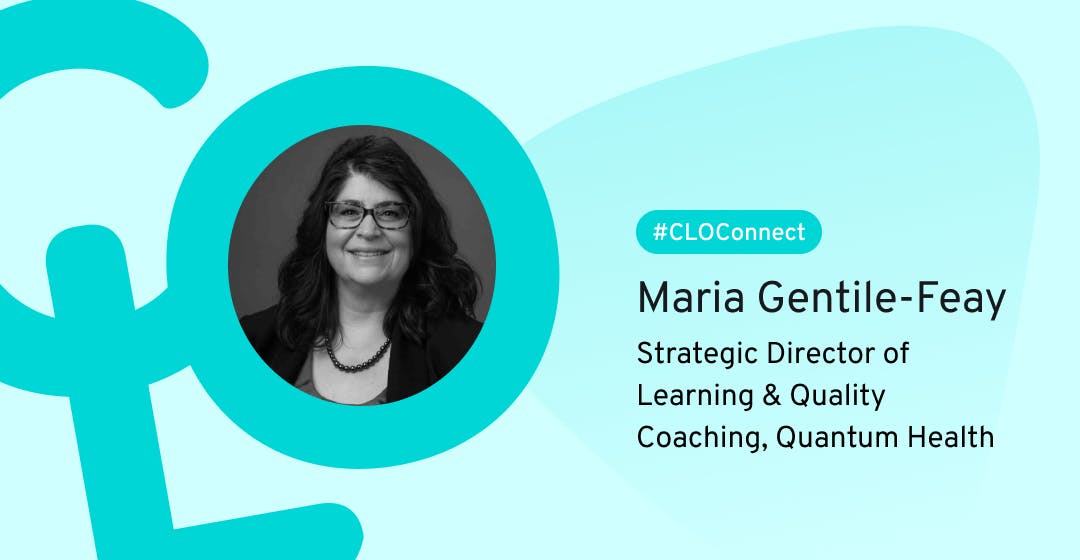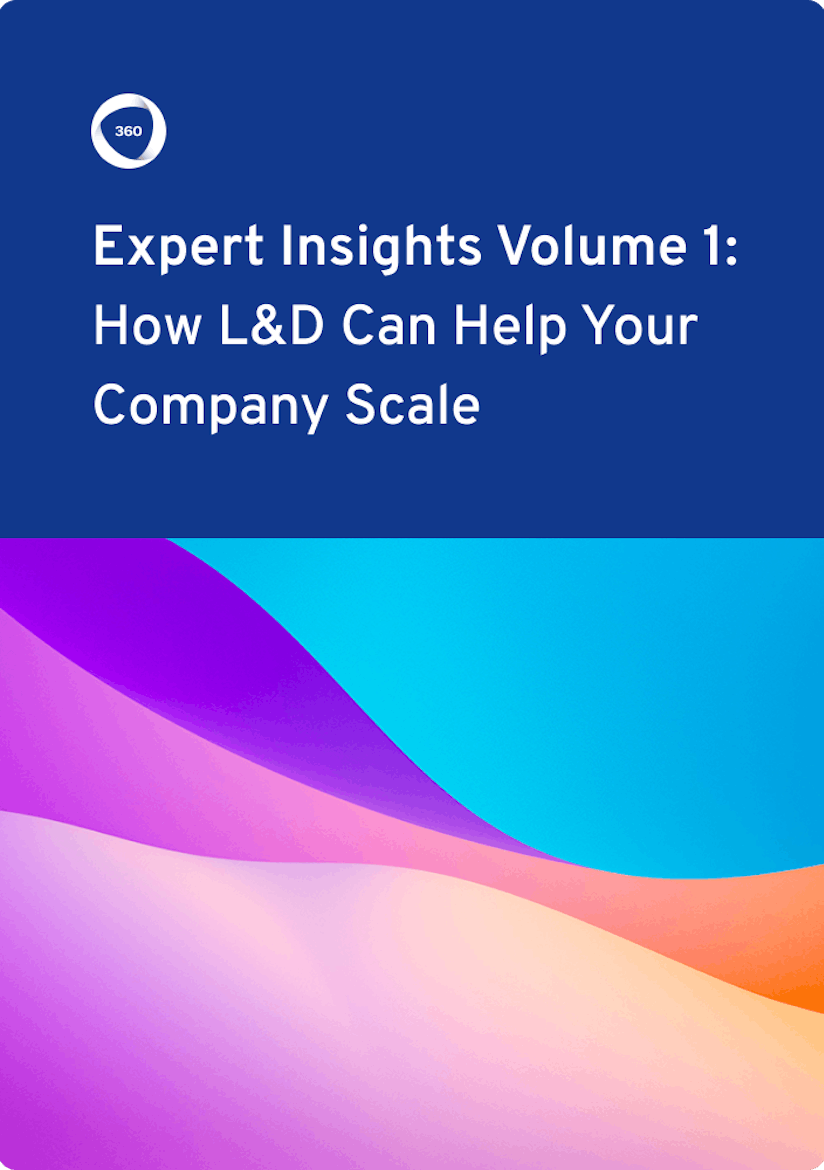
Empathy-Focused L&D: Quantum Health’s 5 Steps to Being a Successful Learning Business Partner
As L&D leaders, we are fully aware that the operational learning space can be a real challenge, especially if your organization is experiencing the excitement that is hypergrowth.
But, how can you scale learning for new hires to match the pace of your organization's growth? And is it possible to design streamlined and straightforward training that is not only empathetic-focused but also creates a complete learning journey?
Answers to these crucial questions and more are why I’m excited to share my latest expert interview with Maria Gentile-Feay, Strategic Director of Learning and Quality Coaching at Quantum Health. Maria was generous enough to tell me about her five-step approach to being a successful learning business partner through empathy-focused L&D.
Read on to hear why empathy-focused L&D and building learning business partnerships are so important for a company like Quantum Health.
Loving what you’re reading? Come and join the L&D Collective for more great learning insights, resources, and events!
The challenge of scaling L&D to match hypergrowth
At Quantum Health, Maria is excited about the organization’s growth and its need to scale. But the operational learning space can be a challenge, especially for organizations that are growing at pace.
“We are the navigators of healthcare for organizations, and so we need to feel confident in what we're doing and to help others understand what their challenges are and what they're facing,” she says.
In Maria’s experience, getting people in quickly and up to speed is all about scale. The learning pieces have to grow to match the organization’s growth.
“It’s about how to scale learning while continuing to embrace a culture of closeness,” she says.
The challenge, as Maria explains, is helping people to understand what they do quickly, evaluate it, and then be able to apply it. “The information is out there but you have to provide it at people’s fingertips—they don't have time to read a lot of stuff. They don't have time to look all over the place.”
It’s about how to scale learning while continuing to embrace a culture of closeness.
“The challenges are really around making sure that the experience for both our members and for our employees is streamlined and straightforward so that employees can do all their empathetic work for them,” she says.
So, how are Maria and her team working to ensure the Quantum Health experience is streamlined and straightforward? Read on to hear about Maria’s five steps to being a successful learning business partner.
Need more CLO Connect expert insights? Find out how WhatsApp, Klaviyo, Amazon, and other market leaders are scaling their organizations with the right L&D strategy.

You have questions–the experts have the answers
By providing your contact info, you agree to receive communications from 360Learning. You can opt-out at any time. For details, refer to our Privacy Policy.
Quantum’s 5-step approach to being a successful learning business partner
In Maria’s experience, people in organizations feel that L&D has to combine everything upfront for someone coming in to do their job.
“But really, it's about instilling confidence and setting people up for success,” she explains. “How do we put information together so that they can learn the basics when they onboard, but then also find it when they’re actually working through these problems later on.”

So, how does Maria and the team set members and employees up for success? It all starts with setting a key goal.
1. Set a key learning goal
Maria and the team have always got their key goal in mind: whose responsibility is the member experience? This is the starting point.
“Every one of us,” she says. “So, we've got to figure out no matter whether we're building the system or figuring out what the benefits are for different organizations, the key goal matters the most.”
“A couple of things that we have focused on to define the key goals are looking at what we do as we bring people on board, how we streamline that activity, and how we start figuring out where the gaps are.”
2. Collaborate with stakeholders
Maria’s answer is to be a business partner because in many organizations when there is a problem, the go-to solution is to find the training or trainer.
At Quantum Health, Maria works with teams by partnering with them and letting L&D be the translators. “Operationally, you've got to figure out what the process is going to be within that space. So, what are we going to do for x? And then we translate that so that people can learn it.”
3. Standardize the intake process
Once they have a seat at the table, the L&D team can start focusing on questions such as why is training needed? What is the reason? Who are the people that will benefit? And what is the impact?
“We standardize that process of what I would call intake so that we can track some of that and understand what the gaps are and then we can help the rest of the business understand that,” Maria says.
4. Quality is about recertification of skills
As Maria explains, she has always believed that quality is the recertification of skills.
“So, you come in, you teach, you help people to understand, they learn, they apply what they're learning, and they build up their skills,” she says. “But how do you show that you recertify but also continue the coaching?”
The answer at Quantum Health is another key part where the quality team is really the coaches on the bench for learners. “So, they are listening, helping to guide, and increasing their skill set, but doing it in a coaching manner,” says Maria.
5. Connect to the metrics
Finally, all the previous elements come together when they are connected to the business metrics—the final step in Maria’s five-step approach to being a successful business partner.
“Do some type of business review,” she says. “A couple of times a year you say, here are some of the problems that we've helped you solve, here's what we did, and here's the continued work that we will do to continue to provide value.”
“By partnering with our stakeholders, that's instilling the success and helping them to be competent in what we're doing too. It’s a twofold piece that brings you to a full business partnership where you're at the table solving problems.”
By partnering with our stakeholders, that's instilling the success and helping them to be competent in what we're doing too. It’s a twofold piece that brings you to a full business partnership where you're at the table solving problems.
Quantum Health’s empathy-focused approach to being a successful learning business partner highlights the advantages of collaborative learning. By giving learners access to the quality team who act as coaches, Maria and her team are creating an environment where people can be heard and guided to grow their skillset.
So, that’s Maria’s strategy for setting up a successful learning journey, but how does she know her team is making an impact?
Related: Udacity’s 4 Steps for Creating Memorable Learning Experiences with Subject-Matter Experts
Build a scorecard to measure impact
As Maria explains, Quantum Health has been growing and stretching the muscle around metrics. Right now, she's looking at how she connects the dots with her team.
“I always say training is an event but learning is a complete journey,’ she says. “And so if we follow that journey from onboarding on, and we look at maybe a 30/60/90 process, we can look at things like attrition because we also want to measure the engagement upfront.”
Maria and her team have been looking at attrition in spaces such as people coming in, new performance happening, and what is occurring to company culture. They have also been building a scorecard around quality up front, the time that people are spending on the phone, and some productivity touchpoints they identified through a workforce group.
I always say training is an event but learning is a complete journey.
“We’ve also focused on speed to competency,” she says. “We can easily see people are doing well and we feel pretty good about their ability to service our members at this point. Those things all come together in the scorecard.”
Maria also recommends that you look at ways to identify if people, as they come out, feel they got what they needed and if there were gaps. “There's a kicker there around the engagement piece. You want to ensure that people feel connected.”
To ensure people feel connected, Maria and the team are implementing what they call cultivation which focuses on connecting people to a team and engaging them with the organization.
“We have started to measure not only attrition but engagement in that timeframe to ensure that people feel like they’re present, they’re moving along in the journey, and they’re able to identify the people that are supporting them in the journey. Those metrics are so critical in the operational space,” she says.
Related: Did That Training Really Work? Measuring the Impact of L&D with Kevin M. Yates
Two tips for making the greatest possible impact
When you start working with stakeholders, you need to be aware that they face problems—it’s critical that you empathize with those challenges and set a clear vision of how you will help them overcome them, explains Maria.
“So, the more we can partner with stakeholders to help them get there, the more you will be that trusted partner. I think that is fundamental in what I call ‘Good to Great’. We can have a program but is it really going to be great if we're not all engaged in what's happening?” she says.
In addition, Maria never looks at L&D as just a group on the side. “We are involved in the operation and are making things happen. As you start to identify that as a learning business partner, it changes the game because then you realize I'm going to help people and I'm helping them get prepared to do this terrific work,” she says.
Thanks to Maria for sharing her business partner insights and experience with us!
For more stories and tips about building collaborative partnerships within your organization, check out our interviews with Stephanie Lynch of Airbnb on the power of creating shared learning experiences through multicultural training, and Missy Strong of Aircall on scaling manager training to drive growth.
Want more peer insights on transforming workplace learning? Sign up to become a member of the L&D Collective, and check out our other #CLOConnect interviews with top L&D leaders on driving growth and scaling culture through Collaborative Learning. Or you can subscribe (below 👇) to our weekly newsletter to receive our latest posts directly in your inbox.

